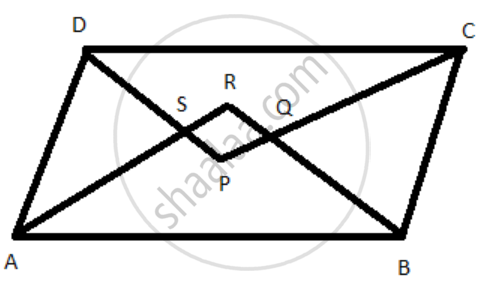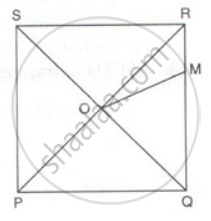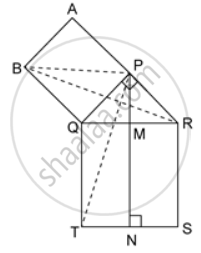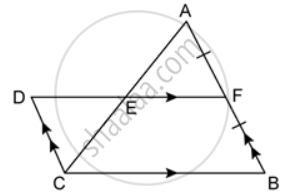Advertisements
Advertisements
Question
Prove that the bisectors of the interior angles of a rectangle form a square.
Solution
Given: A parallelogram ABCD in which AR, BR, CP, DP are the bisects of ∠A, ∠B, ∠C, ∠D, respectively forming quadrilaterals PQRS.
To prove: PQRS is a square.

Proof:
In Δ ARB,
∠RAB + ∠RBA + ∠ARB = 180°
45° + 45° + ∠ARB = 180°
90° + ∠ARB = 180°
∠ARB = 180° - 90°
∴ ∠ARB = 90°
Similarly, ∠SRQ = 90°
In Δ ARB,
AR = BR ...(i)
ΔASD ≅ Δ BQC ...[By ASA rule]
AS = BQ ...(ii) [by CPCTC]
(i) - (ii)
AR - AS = BR - BQ
SR = RQ ...(iii)
Also, SP = PQ ...(iv)
PQ = RS ...(v)
Hence, PQRS is a square.
APPEARS IN
RELATED QUESTIONS
All rectangles are squares
All squares are rhombuses and also rectangles.
All squares are not parallelograms.
Explain how a square is a rectangle
In square PQRS :
(i) if PQ = 3x – 7 and QR = x + 3 ; find PS
(ii) if PR = 5x and QS = 9x – 8. Find QS
PQRS is a square whose diagonals PR and QS intersect at O.M is a point on QR such that OQ = MQ. Find the measures of ∠MOR and ∠QSR.
Prove that the quadrilateral formed by joining the mid-points of a square is also a square.
In the given figure, ΔPQR is right-angled at P. PABQ and QRST are squares on the side PQ and hypotenuse QR. If PN ⊥ TS, show that:
(a) ΔQRB ≅ ΔPQT
(b) Area of square PABQ = area of rectangle QTNM.
In the given figure AF = BF and DCBF is a parallelogram. If the area of ΔABC is 30 square units, find the area of the parallelogram DCBF.
In a parallelogram PQRS, T is any point on the diagonal PR. If the area of ΔPTQ is 18 square units find the area of ΔPTS.
